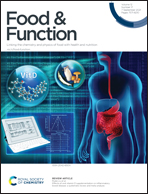RD43 rice flour: the effect on starch digestibility and quality of noodles, glycemic response, short-acting satiety hormones and appetite control in humans
Abstract
The aim of this study was to develop wheat noodles substituted with 10–40% RD43 rice flour. Starch digestibility and physicochemical and sensory properties of RD43 rice noodles and its effect on glycemic response, gut hormones, and appetite sensation in humans were also determined. The results demonstrated that the substitution of 10–40% RD43 rice flour reduced starch digestibility, the hydrolysis index, and rapidly digestible starch (RDS), while increasing undigestible starch in noodles. Noodles prepared with 30% RD43 rice flour slightly increased water absorption (WA), and the swelling index (SI) without altering cooking loss. When compared with the control, 30% RD43 rice showed higher lightness (L*) and lower redness (a*), yellowness (b*) and hardness with similar overall acceptability. In human studies, ingestion of 30% RD43 rice noodles significantly lowered postprandial plasma glucose at 15–90 min. Interestingly, the postprandial concentration of glucagon-like peptide-1 (GLP-1) and peptide tyrosine–tyrosine (PYY) also significantly increased at 30 min after the intake of 30% RD43 rice noodles. A significantly lower desire to eat and higher fullness were detected after 30% RD43 rice noodle consumption until 120 min. This suggests that RD43 rice flour could be a potential ingredient in noodles for controlling the glycemic response, short-acting satiety hormones, and appetite sensation.



 Please wait while we load your content...
Please wait while we load your content...